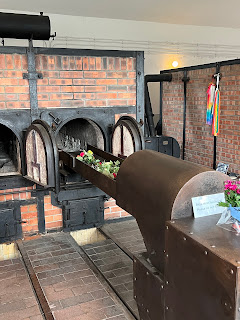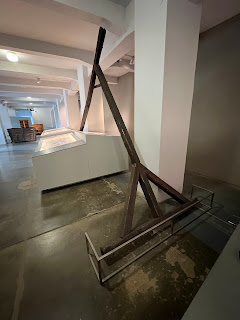Wetzlar, Buchenwald
May 9, 2024
Today was a difficult for several reasons; it was cold windy and dark, but considering we were to visit Buchenwald it was very appropriate. At the end of the war Buchenwald was the largest concentration camp in Germany. It is an expansive property, and even though many of the barracks and other buildings are gone, there is no question or doubt of its inhuman mission. The barbed wire, guard towers and large chimney of a foreboding building on the edge of the compound brought reality to the stories I’ve heard and read about.


Our guide for the day, Mackenzie, shows us the front gate. The inscription “to each his own” is positioned to be read by the prisoners from the inside.

Nazi headquarters and administration building.
Solitary confinement was the main type of punishment in the camp. The cells were small, and completely void of facilities. Some had a wooden cot to sleep on, and others had chains attached to the walls where shackled prisoners were hung in painful positions.
My father was shackled to his buddy, Ed Staley on the punishing run up the hill to Stalag Luft IV. I wonder what his shackles looked like.
Jewish prisoners were not generally executed in Buchenwald, it was known as a punishment and work camp. Jewish prisoners were “rented” out to businesses and corporations as free labor. Interesting that many of these prisoners got better treatment from their captors than those working in the rock quarry adjacent to the camp. Almost sixty thousand died there, but for the large majority, starvation was the cause of death. I’m having trouble making the number of victims here to be sixty thousand because most references quote 1.1 to 2 million. .
Buchenwald had many satellite camps, maybe hundreds of them. I’m guessing that the larger number included all the executions in all the various iterations of Buchenwald.
The Nazi officers kept a brothel in the camp of girls ages about ten to eighteen. They also built a camp Zoo for the children of the officers.
Prisoners were subjected to horrific medical experiments in the name of research.
The most graphic building of the tour was the crematory. The pictures tell the story.
The extensive museum at Buchenwald continued to tell the story.
I mentioned that Buchenwald was not an execution camp like Auschwitz, but they did execute all captured Russians. The captives were taken to the basement of the crematorium and shot. The bodies were then placed on a lift and moved to the crematory and disposed of. The picture below is a cart used to carry the Russian bodies to the crematory before the lift was installed.
The memorial to the Buchenwald prisoners is a square stainless steel plate with names of the fifty countries represented by those imprisoned. America is represented because two American airmen died here on route to their Stalags. They were not executed but died from injuries sustained during battle. The plate is held at constant 98.6 degrees by a heater underneath to represent “life”.
Our visit to Buchenwald was not a direct part of the history of our fathers POW experience but it magnifies the importance of why our country was willing to fight and send men like my father to war. Jim

















